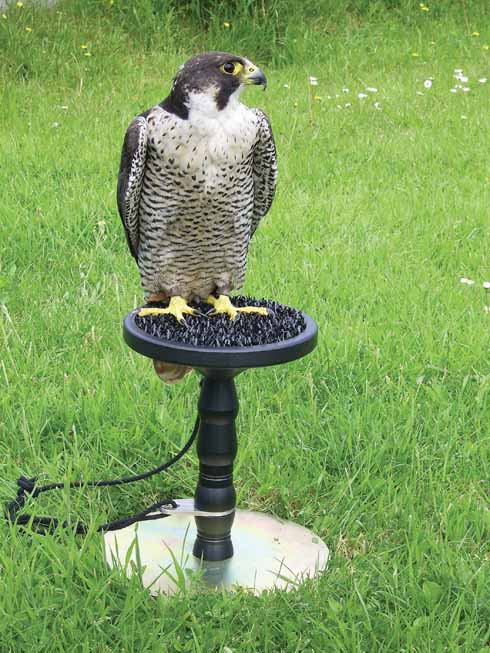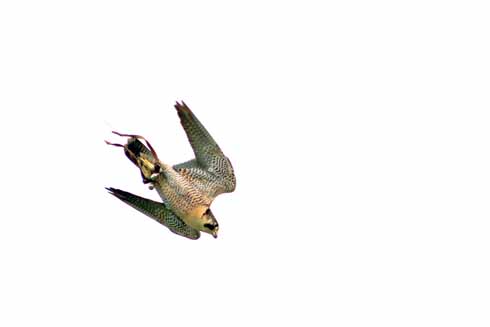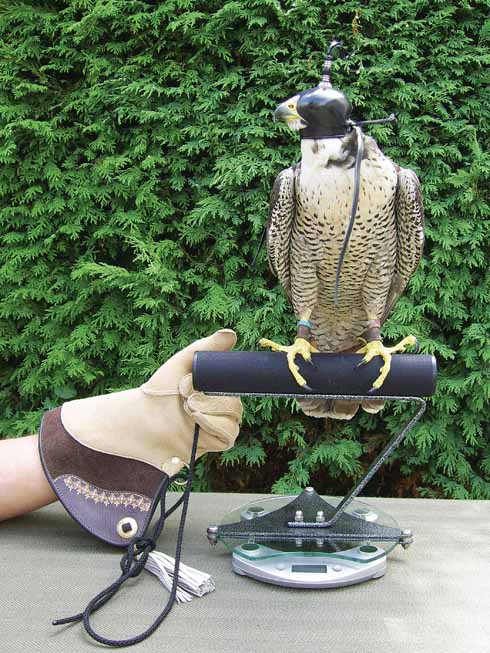A falconer’s tale
Steve Davis recalls an unusual day's peregrine training
Published in December ’12
After forty minutes walking over crackling stubble under a cloudless sky near Burton Bradstock, there was still no wind and I was getting hot. The cereal aftermath had the odd lump of stone, bare patches of dust, mud and the occasional patch of cut, withered weeds. On one hand I was carrying a hooded falcon, I was also weighed down with a hawking bag and telemetry receiver.
The cereal stubble finished and a low stone wall, topped with wire, formed a boundary. I skirted it, watched by curious sheep which, realising I was not a threat, returned to grazing. A patch of ‘red-hot’ nettles gave way to a small gateway, through which I passed and continued my climb across the close-cropped grass. At the top was the Bridport to Dorchester road; I stopped walking one field short
of it.
Pausing to catch my breath, I turned to take in the view. In the distance the sun twinkled on the sea; looking down, I could just make out my car, parked in the farmyard. On the far side of the valley, a small blue tractor was beginning to turn the soil, while, in its wake, an attentive plume of gulls looked
for bounty.
At this height, a slight breeze kept the flies away; it smelt of hot hay, stubble and heaven. Below me, a single buzzard soared, while in the valley base doves flitted around a farmhouse.
The hooded tiercel – a male peregrine falcon, roused, shook himself and then, thinking better of it, settled back on my glove. As my breathing returned to normal, I hopped while trying to hook out a piece of mud that had worked its way in to my shoe.
That irritation gone, my life purpose took over and I began to prepare my friend for his work. Earlier, I had cable-tied a small transmitter to one of his anklets and, from habit, thrown a switch on the receiver to hear the muted chirrup.
Although the falcon was hooded, he knew what was coming and he shuffled his feet on the glove. I made reassuring noises, gently whistled his call and started to look along the valley sides and at the stubble with more interest. The game seasons were not yet open and it was early in his year; he was just still finishing his moult, at the beginning of which I’d fed him with all he could eat, and given him a holiday. This home-bred falcon was now in his third year and beginning to look very smart in his adult plumage. I reached down with my right hand to made sure that the reassuring shape of his lure could be felt; the other smaller pocket held a few bechins (tidbits) and two, dead day-old chicks. I pulled the cross strap holding the transmitter receiver back around behind me, tucked my shirt back inside my belt and I too was ready.
I struck the hood braces with my teeth and right hand and, after a small interval, the hood was rolled forwards and then off. The falcon looked quizzically at me, I held him into the wind and he began bobbing his head at something beyond my vision. He turned his head around, taking in the view, then roused and shook vigorously.
Through the glove I felt him clench his talons, then, with a gentle bowling movement, he was sky borne, with just an echo from his leg bells, flying into the wind, gaining height effortlessly. After two hundred yards he turned and started flying circles around me, gaining height with each revolution. As he turned into an up draught, I saw his head turn in my direction.
I started walking down the valley side, back down through the sheep field and over the wall, all the while trying to keep him in view, just flashing the lure to get him back over me. A strong whistle always got him looking at me, and back overhead. This sort of flying at this time of year is primarily to do with fitness. The beauty of these Dorset hills is that they get a falcon used to waiting on at a proper height.
Suddenly, with an immense chattering, a magpie burst from the hedge at the side. It was one field over from the waiting, circling falcon, which immediately twitched and folded straight towards it. I watched, spellbound, as the peregrine formed the classic closed-anchor shape and plunged from above, rapidly overhauling the magpie, which had stopped chattering and was powering towards a small copse on the far side of the valley. Like a knife, my falcon cut through the air, got a touch at one wing, as the pie feinted left and virtually fell out of the sky, trying to outsmart the falcon. The falcon overshot and turned swiftly, gaining height, then it put in a deadly stoop, and bound to the magpie. They both came down out of my sight, on the far side of a hedge. I ran as fast as I could back up the hill trying to find a way through the hedge, eventually finding an old gate held by miles of twine. In front of me was an acre or more of watery tussocks, open water, rushes and bogs. I was lost and did not know where he was; I could neither hear bells, nor see tell-tale feathers.
When all else fails, try electronic telemetry: he was about fifty yards away, hidden by a large reedy lump. I was pleased to find him – he seemed ambivalent – and I put in one weathering jess, fixed the swivel, and then to it, a leash, which was knotted to a sheath knife plunged firmly into the ground.
As he fed, I stood back and watched, replaying the flight in my head, again and again. The sun slipped slowly to the horizon – a sinking red disc over Lyme Bay. With his crop now full, I picked up my passion, hooded him and took him back to the car, and thence to his mews.





